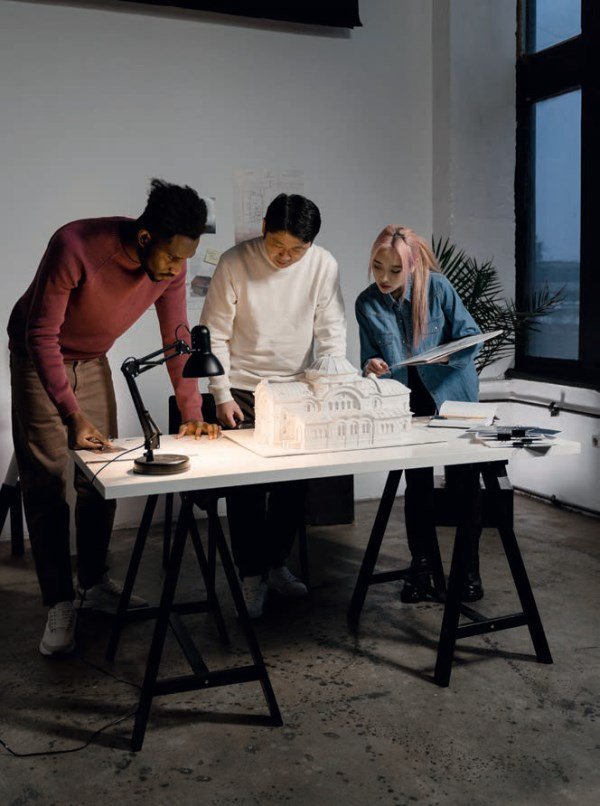This article was originally published in Architectural Review: Issue 170 and was written by Tracey Porter.

A new model of ownership is being hailed as the answer to succession planning issues across practices in the UK and across the US. But it appears architectural firms here are yet to be convinced.
It is clear COVID-19 has transformed the way employees engage with their paymasters. Remote working, talent shortages, asynchronous office hours and wage subsidies are just some of the economic and employment consequences of the global health crisis that has redefined the way we work.
Yet while the design sector, unlike the hospitality or tourism industries, may have escaped the worst of the negative economic impacts wrought by the pandemic, uncertainty around future job stability, as well as the difficulties faced in selling design businesses, has allowed the topic of employee ownership to gain traction.
A growing trend
An alternative to traditional hierarchical architecture practice, employee ownership in itself is not a complex system. It can be direct (where employees become individual shareholders), indirect (where shares are held collectively on their behalf, usually by an EOT or Employee Ownership Trust) or a hybrid of the two.

But for architectural practices in particular, transitioning to an employee ownership structure offers governance that champions collaboration alongside improved employee engagement and succession arrangements.
Numerous studies indicate that workforces with a vested interest in the company are more productive, less likely to move elsewhere and are more innovative.
This is a fact not lost on the design sector in the UK, which has witnessed both big and small architecture practices, including Studio Egret West, LDA Design and Zaha Hadid Architects, make the move in recent years.
Figures from the Royal Institute of British Architects (RIBA) show exponential growth in the number of its member organisations owned by EOTs, rising from 75 in 2020, to 110 in 2021.
The local perspective
Yet while it is a popular solution for those in the logistics and technology industries in Australia, for a variety of reasons the uptake has not proved as swift among architectural practices here.

Last year Meld Studios, a design company with studios in Sydney, Melbourne, Canberra and Perth, became the first Australian company to operate an EOT.
It joined a small but exclusive group of design businesses in the country to embrace an employee-led ownership model – including Brisbane-based Maytree Studios (where the owner allocated shares to a couple of employees, while remaining the majority shareholder) and multinational and multidisciplinary practices Arup and Purcell. The latter two have full EOTs, but only have offices in Australia, while being headquartered elsewhere.
A good option
Sir Ove Nyquist Arup founded Arup in 1946 and its Australian arm has worked on numerous transport and infrastructure projects including the Sydney Opera House, the Brisbane Metro and the Elizabeth Quay Bridge in Perth. The company first began transitioning to an employee-led ownership model back in the 1970s.
Arup deputy chair Tristram Carfrae says the decision came about when Sir Ove turned 80 and sought to retire from the practice.

Believing it was unreasonable to leave the ownership of the firm to offspring when they potentially had no interest in the firm’s main disciplines of architecture and engineering, he set about creating a legacy that would remain long after he had departed.
Carfrae says because the decision was made to govern Arup via an EOT, employees don’t actually own any shares in the company. Instead, they own a share on the profit that the company makes.
“BEING A HUMANE ORGANISATION IS NOT A MEANS TO AN END FOR US, IT IS THE END IN ITSELF. THOSE OF US WHO LEAD THE FIRM, WE THINK OF OURSELVES AS STEWARDS, NOT OWNERS.” – TRISTRAM CARFRAE
“Therefore there is nothing of any value that they own or have to purchase, they get given it on arrival and it gets given back to the firm on departure. We refer to it as ‘naked in, naked out’. Their profit share is simply a consequence of their employment,” he says.
In removing the tension among the partners about profit distribution that often comes with traditional ownership structures, the employee-shareholders are better able to focus on the quality of the work while also making the well-being and career development of every individual in the firm a priority.
Carfrae says this means the business is able to operate with more autonomy, attract better talent and invite more imaginative project opportunities.
“Then they tend to stay because there’s less pressure, there’s more of a community spirit, there are other really interesting people for them to work with who have also come and stayed and they can develop in their own way.
“Being a humane organisation is not a means to an end for us, it is the end in itself. Those of us who lead the firm, we think of ourselves as stewards, not owners. Our job is to try and make the firm better and stronger for the future, for the next set of stewards.”
Things to look out for
But Carfrae also acknowledges that while EOTs are an attractive proposition for owners of architectural practices looking to exit their business, they are not without risk. This is particularly true in cases where the business may be carrying residual debt.
Carfrae says, in theory, owners could also pay a bit more salary and less profit share, but argues there are “all sorts of complications” that come with that.
“Whatever happens you don’t want to make a loss – and we never have by the way. But it’s not something that people can rely on either. It’s variable pay. Something could go wrong in one part of the world that means we could lose all the money that we’ve made somewhere else and we’d have no money to distribute.”
Ray Brown, the co-founder and chief mentor at architecture implementation consultancy ArchiBiz, says the most successful transitions to employee ownership have always involved a degree of generosity from the retiring partners.
According to Brown, where things traditionally go wrong in employee ownership structures, however, is when ego plays a part, relationships are eroded, and legal, financial and moral considerations are not clearly defined.
He says the worst thing owners, can do to disrupt company culture is to start distributing shares without giving consideration to what that actually means.
Alongside seeking professional advice from their lawyer, accountant and tax advisory group, practice owners should instead acquire a professionally drawn up shareholders’ agreement that covers points like the sales of shares, whether the shares are to be purchased as part of a stock ownership plan or whether they will be gifted as part of the employees’ remuneration.
“IF YOU DO IT RIGHT, IT’S MUTUALLY BENEFICIAL FOR THE PEOPLE COMING IN AND THE PEOPLE EXITING TO GET SOME VALUE FOR THEIR EQUITY.” – RAY BROWN
“I would advocate that some money needs to change hands when shares are distributed,” says Brown. “My preferred option would be for employees to buy the shares, to get skin in the game. If you’ve got to borrow $50,000 to buy the shares, I think you’re more invested in the future success of the business. It’s also the right thing for the person who started the business… if they’re going to transfer some shares, there should be some money exchanged.”
It’s also important for business owners to remind their shareholders that shareholding is predominantly about profit, not decision-making, he says.
Brown says too often businesses that have gone down this route encounter power struggles further down the track because some employees fail to note the distinction between the shareholders and the board.
“Ownership of shares doesn’t mean to say you make all the decisions or can be involved in all the decisions. You can’t just think I’ll knock off at three pm on Friday because I am a shareholder. If ownership begins to colour people’s judgement and decision-making then that can only be counterproductive to the business.”
Brown says the best businesses recognise that when it comes down to it, the shareholding should have nothing to do with the business and the values of the business.
“If you do it right, it’s mutually beneficial for the people coming in and the people exiting to get some value for their equity. But if the business stops trading, your business is worth nothing regardless of who owns it.”
To access the full digital version of AR170, please click here.
If you want to learn more about employee ownership and whether this could be a good fit for your practice, contact us using this form and we’ll schedule a time to chat about your business and how we might be able to help.
